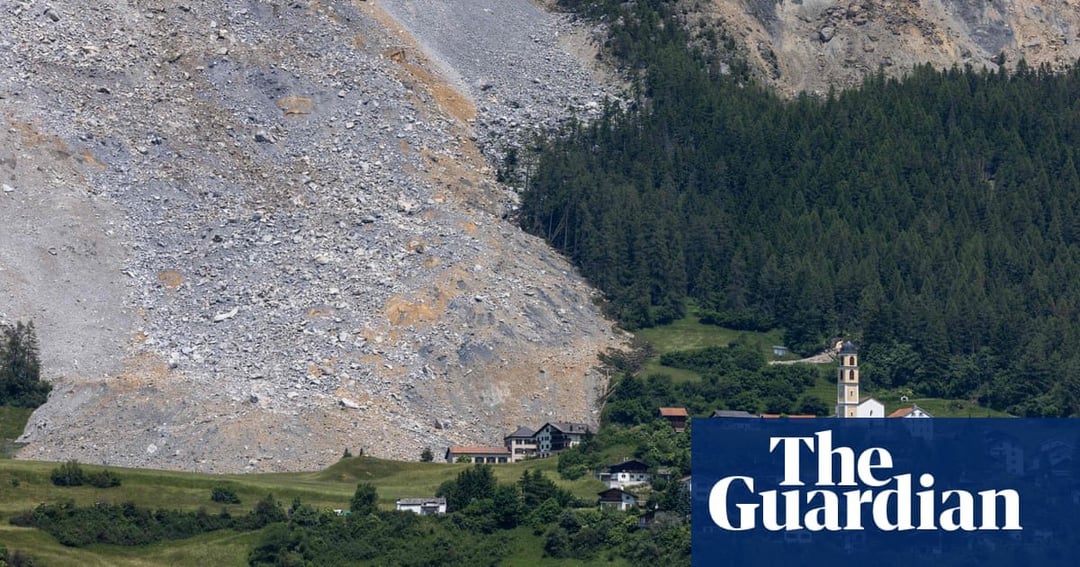Assessing The Landslide Risk In A Swiss Mountain Village

Table of Contents
Geological Factors Contributing to Landslide Risk
The inherent geological characteristics of Swiss mountain regions significantly contribute to landslide susceptibility. Understanding these factors is the first step in effective landslide risk assessment.
Slope Angle and Material
Steep slopes are a primary factor increasing landslide risk. Combined with unstable soil types, the potential for catastrophic events rises dramatically. Many Swiss mountains are composed of various soil types, each with varying degrees of stability.
- Common Unstable Soil Types: Weathered shale, loose moraine deposits, and certain clay formations are particularly prone to landslides. These soils often lack cohesion and are easily saturated by water, dramatically reducing their shear strength.
- Influence of Water Saturation: Water acts as a lubricant, significantly decreasing the frictional resistance between soil particles. This leads to a decrease in slope stability, making landslides more likely, especially during periods of heavy rainfall or rapid snowmelt.
- Examples of Past Landslides: Numerous historical landslides in Swiss mountain villages highlight the devastating consequences of unstable slopes and soil types. These events often serve as crucial case studies in understanding and mitigating future risks.
Hydrological Influences
Water plays a pivotal role in triggering landslides. Heavy rainfall, rapid snowmelt, and fluctuating groundwater levels all contribute to slope instability.
- Rainfall Saturation: Prolonged or intense rainfall saturates the soil, increasing its weight and reducing its shear strength. This can lead to shallow or deep-seated landslides, depending on the soil profile and rainfall intensity.
- Impact of Rapid Snowmelt: Spring snowmelt can rapidly increase groundwater levels, saturating soils and destabilizing slopes. This effect is amplified in areas with high snow accumulation and rapid temperature increases.
- Groundwater's Destabilizing Role: High groundwater levels exert pore water pressure within the soil, reducing its effective stress and increasing the likelihood of failure. Monitoring groundwater levels is therefore crucial for landslide prediction.
- Rainfall Data and Historical Landslide Events: Analyzing historical rainfall patterns and correlating them with past landslide events provides valuable data for predicting future risks and developing early warning systems.
Seismic Activity
While less frequent than hydrological triggers, seismic activity can induce significant landslides, particularly in areas already predisposed to instability.
- Seismic Wave Destabilization: Earthquake-induced ground shaking can destabilize slopes by increasing pore water pressure and reducing soil strength. This effect can be particularly pronounced in steep, unstable slopes.
- Seismic Activity in Swiss Mountain Regions: Although Switzerland is not located in a highly active seismic zone, historical records demonstrate the potential for significant earthquakes to trigger landslides.
- Impact of Past Earthquakes: Analysis of past earthquake events and their impact on slope stability is essential for understanding seismic landslide risks and incorporating seismic considerations into risk assessment models.
Landslide Risk Assessment Methods
Assessing landslide risk requires a comprehensive approach combining various techniques to accurately identify and quantify the threat.
Field Surveys and Mapping
Detailed field surveys are fundamental to landslide risk assessment. These surveys involve visual inspections, geological mapping, and the use of geophysical techniques.
- Ground Penetrating Radar (GPR): GPR is a non-destructive technique used to map subsurface features, including soil layers, bedrock interfaces, and potential landslide zones.
- Other Geophysical Methods: Other geophysical methods, such as electrical resistivity tomography (ERT) and seismic refraction surveys, are used to further characterize the subsurface geology and identify areas of weakness.
- Aerial Photography and LiDAR: Aerial photography and LiDAR (Light Detection and Ranging) provide high-resolution data for mapping topography, identifying unstable slopes, and creating detailed landslide susceptibility maps.
- Landslide Susceptibility Maps: These maps visually represent the relative probability of landslides occurring in different areas, helping to guide land-use planning and mitigation efforts.
Numerical Modeling
Numerical modeling uses sophisticated computer simulations to analyze slope stability and predict landslide probabilities under various conditions.
- Finite Element Analysis (FEA): FEA is a commonly used numerical modeling technique that divides the slope into small elements and analyzes their behavior under different loads and stresses.
- Input Parameters for Models: Accurate input parameters, including soil properties, groundwater levels, and rainfall data, are crucial for reliable modeling results. The quality of the input data directly impacts the accuracy of the model predictions.
- Limitations of Numerical Modeling: Numerical models are powerful tools, but they have limitations. Model accuracy depends on the quality of input data and the assumptions made about soil behavior.
Early Warning Systems
Early warning systems are vital for mitigating landslide impacts by providing timely alerts to residents and emergency services.
- Types of Sensors: Various sensors, including inclinometers (measuring slope inclination), piezometers (measuring pore water pressure), and extensometers (measuring ground deformation), are used to monitor slope movements.
- Data Usage and Warnings: Data from these sensors is continuously monitored, and any significant changes indicating potential instability trigger warnings.
- Communication Networks: Effective communication networks are essential for rapidly disseminating warnings to residents and emergency responders, allowing for timely evacuation and response efforts.
Mitigation and Risk Reduction Strategies
Reducing landslide risk requires a multifaceted approach incorporating engineering solutions, land-use planning, and community engagement.
Engineering Solutions
Engineering solutions aim to stabilize slopes and mitigate the risk of landslides through structural interventions.
- Retaining Walls: Retaining walls provide support to slopes and prevent soil from sliding. Their design depends on the soil properties and the height of the wall.
- Terraces: Terracing reduces the slope angle, thereby increasing stability. This method is often employed in agriculture and hillside development.
- Drainage Systems: Effective drainage systems remove excess water from the slope, reducing pore water pressure and improving stability.
- Cost and Environmental Impact: Engineering solutions can be costly, and their implementation requires careful consideration of environmental impacts.
Land-Use Planning
Restricting development in high-risk areas is crucial for preventing future losses and minimizing the impact of landslides.
- Zoning Regulations and Building Codes: Land-use planning regulations and building codes should incorporate landslide risk assessments to guide development decisions and ensure the safety of structures.
- Minimizing Future Damage: Careful zoning and land-use planning are critical for minimizing future damage from landslides by preventing construction in vulnerable areas.
Community Education and Preparedness
Community education and preparedness are vital for minimizing casualties and ensuring an effective response to landslides.
- Community Involvement: Actively involving the community in risk reduction efforts, including education programs and emergency planning, fosters a sense of responsibility and preparedness.
- Emergency Preparedness Plans: Well-defined emergency preparedness plans, including evacuation routes and assembly points, are crucial for a rapid and effective response to landslides.
- Education and Public Awareness: Public awareness campaigns educate residents about landslide hazards, warning signs, and appropriate response actions.
Conclusion
Assessing landslide risk in Swiss mountain villages requires a comprehensive and ongoing effort. By integrating geological understanding, advanced monitoring technologies, and effective mitigation strategies, we can significantly reduce the threat of these devastating natural hazards. Combining careful land-use planning with robust early warning systems and strong community engagement is essential for creating resilient and safe communities. Investing in ongoing landslide risk assessment is paramount to protecting lives and property in these stunning yet vulnerable landscapes, ensuring a sustainable future for these unique communities. Continuous landslide risk assessment is key to safeguarding the future of Swiss mountain villages.

Featured Posts
-
 Tour De France Returns To Uk 2027 Grand Depart In Edinburgh
May 23, 2025
Tour De France Returns To Uk 2027 Grand Depart In Edinburgh
May 23, 2025 -
 Zimbabwe Cricket Dominates Muzarabani And Masakadzas Impressive Performance
May 23, 2025
Zimbabwe Cricket Dominates Muzarabani And Masakadzas Impressive Performance
May 23, 2025 -
 Istina O Razvodu Vanje Mijatovic Sta Se Zaista Dogodilo
May 23, 2025
Istina O Razvodu Vanje Mijatovic Sta Se Zaista Dogodilo
May 23, 2025 -
 Nuffy On Touring With Vybz Kartel A Dream Come True
May 23, 2025
Nuffy On Touring With Vybz Kartel A Dream Come True
May 23, 2025 -
 Freddie Flintoffs Face Healed A Look At His Recovery After Top Gear Crash
May 23, 2025
Freddie Flintoffs Face Healed A Look At His Recovery After Top Gear Crash
May 23, 2025
Latest Posts
-
 Revealed Antonys Close Call With Manchester Uniteds Biggest Rival
May 23, 2025
Revealed Antonys Close Call With Manchester Uniteds Biggest Rival
May 23, 2025 -
 Antonys Rejected Offer A Man Utd Rivals Pursuit
May 23, 2025
Antonys Rejected Offer A Man Utd Rivals Pursuit
May 23, 2025 -
 Has Noussair Mazraoui Proven To Be Manchester Uniteds Top Signing
May 23, 2025
Has Noussair Mazraoui Proven To Be Manchester Uniteds Top Signing
May 23, 2025 -
 Jaap Stam Ten Hags Man United Spending A Setback
May 23, 2025
Jaap Stam Ten Hags Man United Spending A Setback
May 23, 2025 -
 The Untold Story Antony And Manchester Uniteds Arch Rivals
May 23, 2025
The Untold Story Antony And Manchester Uniteds Arch Rivals
May 23, 2025
